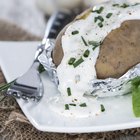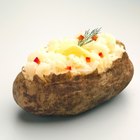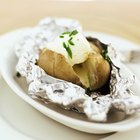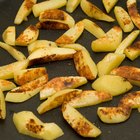
If you've ever mistakenly picked up a hot pan with your bare hand, you'll have a vivid memory of how well metal conducts heat. That ability to transfer heat is why pots and pans are made of metal, and it's why the bars of your grill make attractive marks on your barbecued steaks. You can also harness metal's heat conduction to bake potatoes in less time, using potato nails.
Baked Potatoes 101
The best potatoes for baking are large, starchy varieties such as the Russet Burbank. Russets that have been in storage for at least a few months develop a deep and rich potato flavor, and higher levels of the starches that make them so light, dry and fluffy when they're baked. The simplest baking technique calls for the skins to be punctured so steam can escape, and then for the potatoes to bake at 350 F until they're completely cooked. Some cooks oil the skins to make them extra crisp, while others wrap the potatoes in foil or parchment to keep the skins soft and tender.
Nail Types
Savvy home cooks long ago observed that a potato with a long nail driven through it cooked more quickly than it otherwise would. Potato nails are a commercial product intended for this specific use, manufactured from food-safe metals. Most are made of either aluminum or stainless steel, each of which has its advantages. Aluminum is much better at transferring heat and tends to cook potatoes more quickly. On the other hand, stainless steel nails won't discolor the potato's flesh as aluminum nails will.
Inserting the Nails
Wash and dry your baker potatoes as you normally would, removing any visible blemishes with the tip of a paring knife. Carefully insert the potato nail lengthwise through the tuber, ensuring that at least an inch of the nail extends from either side. That's crucial, because it's the exposed portion of the nail that absorbs heat from the oven and transfers it to the potato. If your nails are too short, insert one from each end of the potato. Stainless steel barbecue skewers make a good substitute, if your potatoes are extra large.
Baking the Potato
Once the nails are in place, prick the potatoes' skins and either oil them or wrap them, if you wish. Put the potatoes in your oven or on the grill, at a temperature of at least 350 F. When you're using nails you have the option of baking the potatoes at temperatures of up to 400 F, which speeds cooking and produces a crispier skin. If you like a soft skin, use the lower temperature. The baking time for potatoes varies with their size and the temperature you choose, but typically a potato that ordinarily takes 1 to 1 1/4 hours will be finished in approximately 40 minutes. The center of the potato should reach 210 F when tested with an instant-read thermometer.
Related Articles
Baking Potatoes With Potato Nails

How to Bake White Potatoes

Can You Over-Bake a Potato?

How to Cut Baked Potatoes

Ways to Cook Baked Potatoes Without Foil
Does a Baked Potato Cook Faster if You ...

How to Get Acrylic Nails Off at Home ...

How to Get Acrylic Off of Cuticles

How to Cook Petite Red Potatoes

How to Bake a Potato Without an Oven

Does Wrapping a Potato in Foil Help It ...

Why Do You Need to Pierce Potatoes ...

Cooking Time for Baked Potatoes Wrapped ...

How to Cook Small Dutch Yellow Potatoes

How to Bake a Potato in 30 Minutes

How to Cook Potatoes for Eight Hours in ...

How to Cook French Fries on a Baking ...
Easy Way to Cook Roasted Red Potatoes

How to Smoke Potatoes

How to Sautee Potatoes
References
- On Food and Cooking: The Science and Lore of the Kitchen; Harold McGee
Writer Bio
Fred Decker is a trained chef and certified food-safety trainer. Decker wrote for the Saint John, New Brunswick Telegraph-Journal, and has been published in Canada's Hospitality and Foodservice magazine. He's held positions selling computers, insurance and mutual funds, and was educated at Memorial University of Newfoundland and the Northern Alberta Institute of Technology.
Photo Credits
Jupiterimages/Comstock/Getty Images